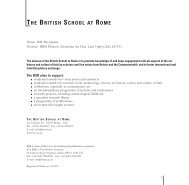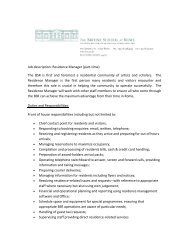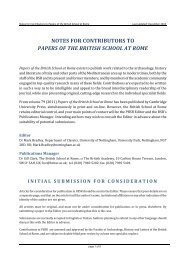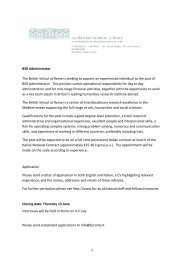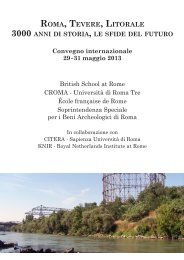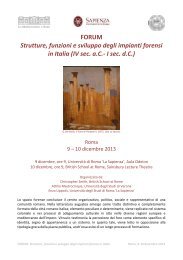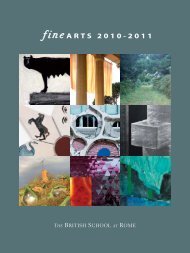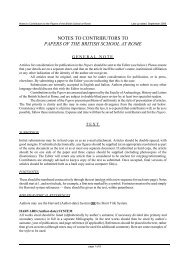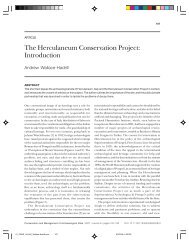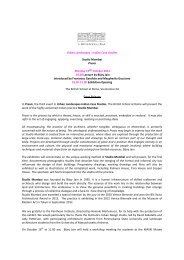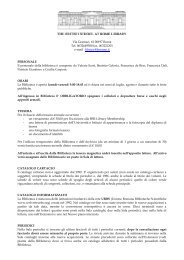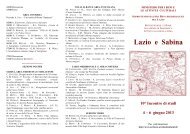fine ARTS 2009-2010 - The British School at Rome
fine ARTS 2009-2010 - The British School at Rome
fine ARTS 2009-2010 - The British School at Rome
- No tags were found...
Create successful ePaper yourself
Turn your PDF publications into a flip-book with our unique Google optimized e-Paper software.
Gwyn Lloyd JonesWHEN FRANK MET FRANCESCOQUANDO FRANK INCONTRÒ FRANCESCO<strong>The</strong> aim of this research was to explore the cross-culturaldialogue between Frank Lloyd Wright (1967-1959) andItalian architecture. Wright’s journeys to Italy were anexample of a cross-cultural exchange th<strong>at</strong> form an importantpart of architectural ‘progress’, and his visit to Fiesole in1910 assisted in coalescing his organic architecture. Afterthe Second World War, Bruno Zevi returned to Italy fromexile to promote Wright, publishing Towards an OrganicArchitecture (1945) – a direct <strong>at</strong>tempt to reclaim the spirit ofmodernism away from Le Corbusier’s functionalistmanifesto. In 1951, Wright’s embodiment of Americanideals and cre<strong>at</strong>ive virility was called upon as a bulwarkagainst the Italian Communists when he opened his ownretrospective in Florence.Within <strong>The</strong> Modern Language of Architecture (1978) Zeviexplicitly confronts <strong>The</strong> Classical Language of Architecture(1964) by John Summerson, presenting an “anti-classicallanguage”, and he claims th<strong>at</strong> the Baroque and Organicarchitecture shared the same “linguistic phenomenon” th<strong>at</strong>was derived from similar sources: the Baroque representedthe dissolution of the Renaissance rigor, medi<strong>at</strong>ed byMannerism, and Wright’s ‘organic’ architecture was a breakfrom the r<strong>at</strong>ionalism of Chicago industrial architecture.Whilst escorting Wright in June 1951, Zevi describes theirlast day together: “...wandering much of the afternoonaround <strong>Rome</strong>, where he met the architect I love most afterWright, the Baroque master Francesco Borromini.”Furthermore, Borromini and Wright were rel<strong>at</strong>ed by anunderstanding of n<strong>at</strong>ure and its primacy in architecture.Zevi’s proposed connection between the organic andbaroque was a stimul<strong>at</strong>ing and contentious analogy.Wright’s early work had Baroque tendencies: <strong>at</strong> the UnityTemple (1905), the centrality and massiveness of theenclosure were apparent, whilst the Robie House (1909)exhibits a perpetual movement and distortion. However,Wright displayed a worrying trend towards the end of hiscareer with bombastic Baroque-Rococo buildings, and itmay be th<strong>at</strong> Wright’s l<strong>at</strong>er work exhibited a Roman Baroqueinfluence. Despite Zevi’s best efforts, the work of Wrightwithin Italy was peripheral, there were individual exemplarprojects where Wright’s work found willing disciples, somemotiv<strong>at</strong>ed by Wright’s ideas, politics or aesthetic – but theywere not a movement and Wright’s architecture remainscontested.Lo scopo di questa ricerca era esplorare il dialogotransculturale fra Frank Lloyd Wright (1967-1959) el’architettura italiana. I viaggi di Wright in Italia furono unesempio degli scambi transculturali che costituiscono unaparte importante del ‘progresso’ architettonico, e la sua visitaa Fiesole nel 1910 contribuì a definire la sua architetturaorganica. Dopo la seconda guerra mondiale, Bruno Zevitornò in Italia dall’esilio per promuovere Wright,pubblicando Verso un’architettura organica (1945) – untent<strong>at</strong>ivo diretto di allontanare lo spirito del modernismo dalmanifesto funzionalista di Le Corbusier. Nel 1951, quandoWright inaugurò la sua retrospettiva a Firenze, si feceappello al suo incarnare gli ideali e la virilità cre<strong>at</strong>ivadell’America quale bastione contro i comunisti italiani.Ne Il linguaggio moderno dell’architettura (1973) Zevi,presentando un “linguaggio anti-classico”, affrontaesplicitamente <strong>The</strong> Classical Language of Architecture(1964) di John Summerson, e sostiene che il Barocco el’Architettura Organica condividono lo stesso “fenomenolinguistico” che era deriv<strong>at</strong>o da fonti simili: il Baroccorappresentava la dissoluzione del rigore del Rinascimento,medi<strong>at</strong>o dal Manierismo, e l’architettura ‘organica’ di Wrightrompeva col razionalismo dell’architettura industriale diChicago. Accompagnando Wright nel giugno 1951, Zevidescrive il loro ultimo giorno assieme, “...vagando gran partedel pomeriggio per Roma, dove egli incontrò l’architetto cheio amo di più dopo Wright, il maestro barocco FrancescoBorromini”. Borromini e Wright erano inoltre leg<strong>at</strong>i dallacomprensione della n<strong>at</strong>ura e del suo prim<strong>at</strong>o in architettura.Il collegamento proposto da Zevi fra architettura organica ebarocca era un’analogia stimolante e controversa. L’operainiziale di Wright aveva tendenze barocche: nello UnityTemple (1905) la centralità e imponenza del recinto eranoevidenti, mentre la Robie House (1909) esibisce un perpetuomoto e distorsione. Peraltro, verso la <strong>fine</strong> della sua carrieraWright manifestò una preoccupante tendenza versoampollosi edifici barocchi-rococò, e può darsi che l’oper<strong>at</strong>arda di Wright mostri un’influenza del Barocco romano.A dispetto degli sforzi di Zevi, l’opera di Wright in Italia fumarginale; vi furono singoli progetti esemplari in cui l’operadi Wright trovò volonterosi discepoli, alcuni dei qualimotiv<strong>at</strong>i dalle idee di Wright, politiche o estetiche – ma noncostituirono un movimento e l’architettura di Wright restacontroversa.30Fine Arts <strong>2009</strong>-<strong>2010</strong>



